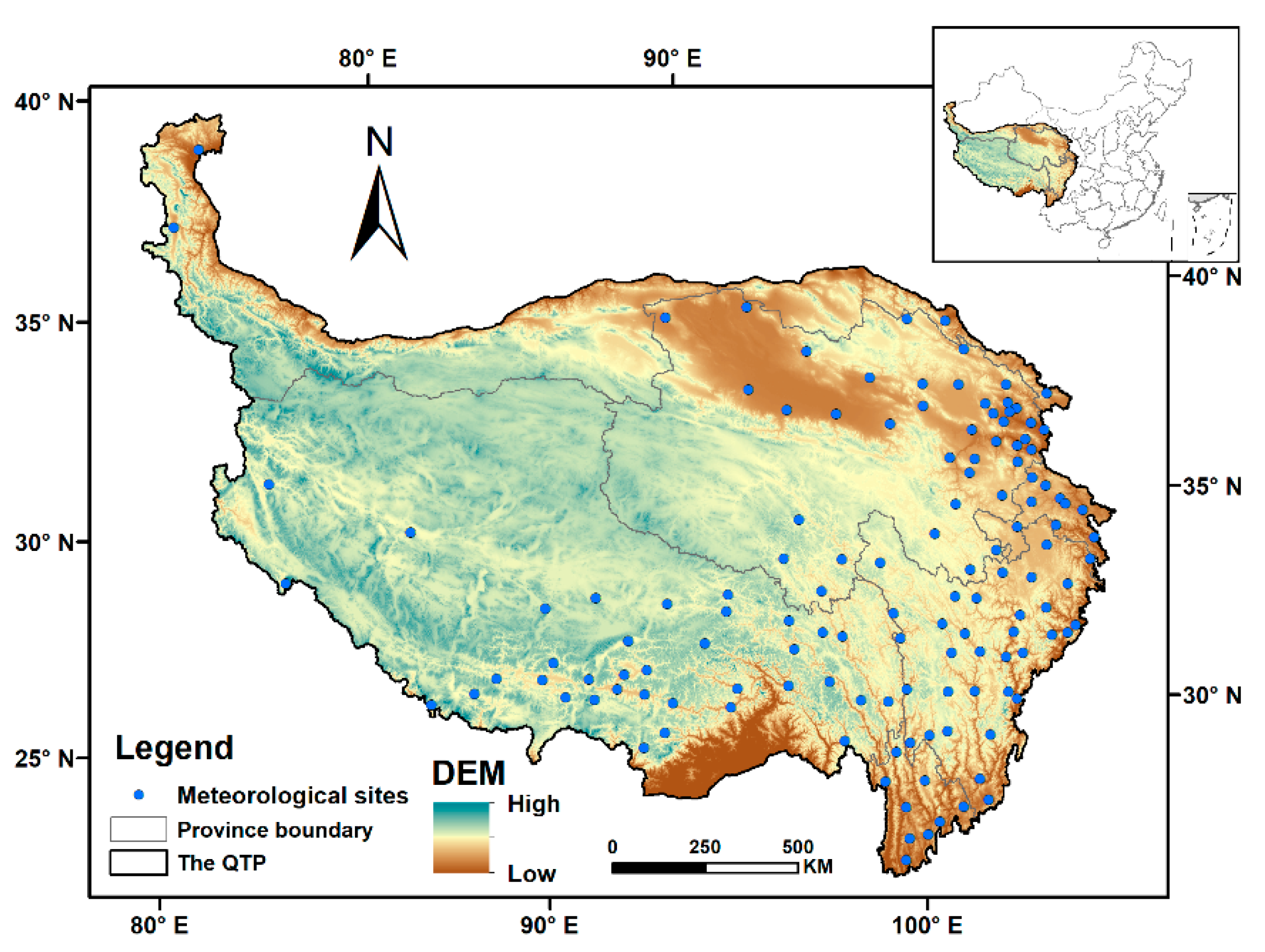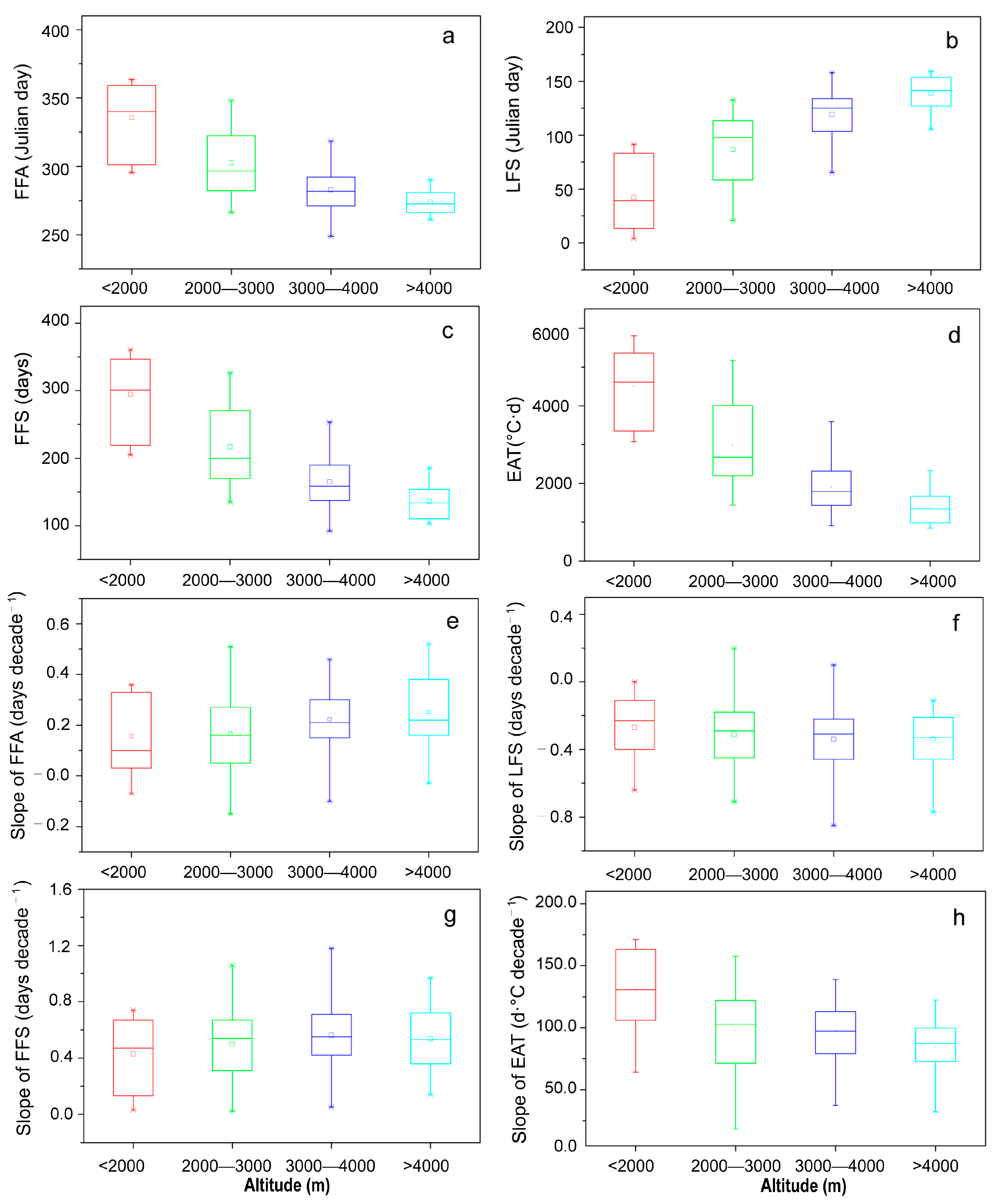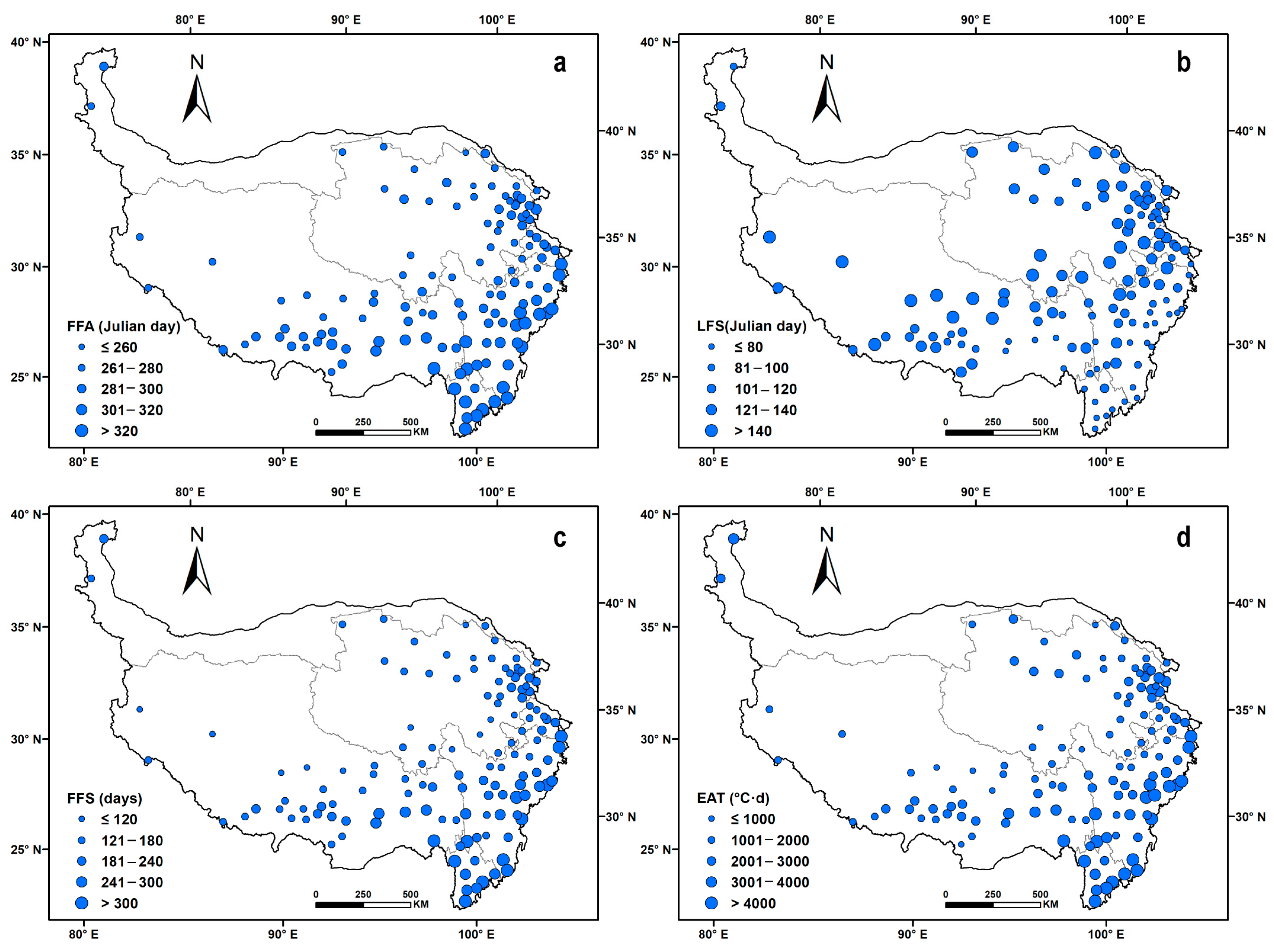Spatiotemporal Changes in Frost-Free Season and Its Influence on Spring Wheat Potential Yield on the Qinghai–Tibet Plateau from 1978 to 2017
Abstract
:1. Introduction
2. Study Area
3. Data and Methods
3.1. Data Sources and Preprocessing
3.2. Calculation of FFS and EAT at the Site Level
3.3. Estimation of Change Rate
3.4. Correlation Analysis
4. Results
4.1. Statistical Analyses of FFS and EAT
4.2. Spatiotemporal Changes in FFS and EAT
4.3. Influence of FFS Change on Spring Wheat Potential Yield
5. Discussion
5.1. Changes in FFS and Its Driving Factors
5.2. Effects of Prolonged FFS on Agriculture
6. Conclusions
Author Contributions
Funding
Institutional Review Board Statement
Informed Consent Statement
Data Availability Statement
Acknowledgments
Conflicts of Interest
References
- Intergovernmental Panel on Climate Change. Climate Change 2021: The Physical Science Basis; Cambridge University Press: Cambridge, UK, 2021. [Google Scholar]
- Piao, S.; Ciais, P.; Huang, Y.; Shen, Z.H.; Peng, S.S.; Li, J.S.; Zhou, L.P.; Liu, H.Y.; Ma, Y.C.; Ding, Y.H.; et al. The Impacts of Climate Change on Water Resources and Agriculture in China. Nature 2010, 467, 43–51. [Google Scholar] [CrossRef]
- Zhang, Y.; Hu, Z.; Qi, W.; Wu, X.; Bai, W.; Li, L.; Ding, M.; Liu, L.; Wang, Z.; Zheng, D. Assessment of effectiveness of nature reserves on the Tibetan Plateau based on net primary production and the large sample comparison method. J. Geogr. Sci. 2016, 26, 27–44. [Google Scholar] [CrossRef] [Green Version]
- Li, C.; Tang, Y.; Luo, H.; Di, B.; Zhang, L. Local Farmers’ Perceptions of Climate Change and Local Adaptive Strategies: A Case Study from the Middle Yarlung Zangbo River Valley, Tibet, China. Environ. Manag. 2013, 52, 894–906. [Google Scholar] [CrossRef]
- Song, Y.; Wang, C.; Linderholm, H.W.; Tian, J.; Shi, Y.; Xu, J.; Liu, Y. Agricultural Adaptation to Global Warming in the Tibetan Plateau. Int. J. Environ. Res. Public Health 2019, 16, 3686. [Google Scholar] [CrossRef] [Green Version]
- Kunkel, K.E.; Easterling, D.R.; Hubbard, K.; Redmond, K. Temporal variations in frost-free season in the United States: 1895–2000. Geophys. Res. Lett. 2004, 31, 1–4. [Google Scholar] [CrossRef]
- Stone, R.A.P.S.; Nicholls, N.; Hammer, G. Frost in northeast Australia: Trends and influences of phases of the Southern Oscillation. J. Climate 1996, 9, 1896–1909. [Google Scholar] [CrossRef]
- Ning, X.; Zhang, L.; Yang, Q. Trends in the frost-free period in China from 1951 to 2012. Acta Geogr. Sin. 2015, 70, 1811–1822. [Google Scholar]
- Labaciren; Suolangjiacuo; Baima. Spatial and temporal distribution of frost days over Tibet from 1981 to 2010. Acta Geogr. Sin. 2014, 69, 690–696. [Google Scholar]
- Zhang, D.; Xu, W.; Li, J.; Cai, Z.; An, D. Frost-free season lengthening and its potential cause in the Tibetan Plateau from 1960 to 2010. Theor. Appl. Climatol. 2014, 115, 441–450. [Google Scholar] [CrossRef]
- You, Q.; Kang, S.; Aguilar, E.; Yan, Y. Changes in daily climate extremes in the eastern and central Tibetan Plateau during 1961–2005. J. Geophys. Res. Atmos. 2008, 113, 1–17. [Google Scholar] [CrossRef] [Green Version]
- Ma, S.; Yang, F. Spatio-temporal characteristics of frost season and its response to climate warming in China. Meteorol. Disaster Prev. 2015, 22, 1–4. [Google Scholar]
- Du, J.; Shi, L.; Yuan, L. Responses of Climatic Change on the Frost Days in Main Agricultural Area of Tibet from 1961 to 2010. Chin. J. Agrometeorol. 2013, 34, 264–271. [Google Scholar]
- Feng, S.; Hu, Q. Changes in agro-meteorological indicators in the contiguous United States: 1951–2000. Theor. Appl. Climatol. 2004, 78, 247–264. [Google Scholar] [CrossRef]
- Bonsal, B.R.; Prowse, T.D. Trends and Variability in Spring and Autumn 0 °C-Isotherm Dates over Canada. Clim. Change 2003, 57, 341–358. [Google Scholar] [CrossRef]
- Scheifinger, H.; Menzel, A.; Koch, E.; Peter, C. Trends of spring time frost events and phenological dates in Central Europe. Theor. Appl. Climatol. 2003, 74, 41–51. [Google Scholar] [CrossRef]
- Meehl, G.A.; Tebaldi, C.; Nychka, D. Changes in frost days in simulations of twentyfirst century climate. Clim. Dyn. 2004, 23, 495–511. [Google Scholar] [CrossRef]
- Han, R.; Li, W.; Ai, W.; Song, Y.; Ye, D.; Hou, W. The Climatic Variability and Influence of First Frost Dates in Northern China. Acta Geogr. Sin. 2010, 65, 525–532. [Google Scholar]
- Bai, Q.; Li, X.; Zhu, L. The changes of the frost–free periods from 1961 to 2010 and its impact on apple industry in Shaanxi province. J. Arid. Land Resour. Environ. 2013, 27, 65–70. [Google Scholar]
- Chen, S.; Zheng, Y.; Lou, W.; Guo, Y. Changes in the First Frost Date from 1961 to 2009 in Northwest China. Resour. Sci. 2013, 35, 165–172. [Google Scholar]
- Li, S.; Shen, Y. Impact of climate warming on temperature and heat resource in arid Northwest China. Chin. J. Eco Agric. 2013, 21, 227–235. [Google Scholar] [CrossRef]
- Wang, B.; Fan, G.; Wei, M.; Hua, W.; Zhao, Y. Frost Spatial and Temporal Variations Analysis in Hengduan Mountains. Plateau Mt. Meteorol. Res. 2014, 34, 17–21. [Google Scholar]
- Pan, S.; Zhang, M.; Wang, B.; Ma, X. Changes of the First Frost Dates, Last Frost Dates and Duration of Frost-free Season in Xinjiang during the Period of 1960–2011. Arid. Zone Res. 2013, 30, 735–742. [Google Scholar]
- Zhang, X.; Lou, J.; Wang, Y.; Wang, Z. Temporal and spatial variation characteristics of first and last frost day and frost period from 1961 to 2017 in northern Xinjiang. Arid. Land Geogr. 2021, 44, 308–315. [Google Scholar]
- Li, F.; Zhang, J.; Wu, Y.; Zhou, J.; Cheng, Y. Spatial and temporal distribution and its impact factors of the last frost over Shanxi Province from 1961 to 2010. Acta Geogr. Sin. 2013, 68, 1472–1480. [Google Scholar]
- Wang, L.; Wu, Z.; He, H.; Wang, F.; Du, H.; Zong, S. Changes in start, end, and length of frost-free season across Northeast China. Int. J. Climatol. 2017, 37, 271–283. [Google Scholar] [CrossRef]
- Du, L.; Zhao, G.; Yang, L. The Variation Characteristics Analysis of Frost in Chongqing City in Recent 40 Years. Chin. Agric. Sci. Bull. 2014, 30, 279–283. [Google Scholar]
- Liu, B.; Henderson, M.; Xu, M. Spatiotemporal change in China’s frost days and frost-free season, 1955–2000. J. Geophys. Res. 2008, 113, 1–15. [Google Scholar] [CrossRef] [Green Version]
- Li, H.; Liu, G.; Han, C.; Yang, Y.; Chen, R. Quantifying the Trends and Variations in the Frost-Free Period and the Number of Frost Days across China under Climate Change Using ERA5-Land Reanalysis Dataset. Remote Sens. 2022, 14, 2400. [Google Scholar] [CrossRef]
- Zhang, Z.; Lu, C. Assessing influences of climate change on highland barley productivity in the Qinghai–Tibet Plateau during 1978–2017. Sci. Rep. 2022, 12, 7625. [Google Scholar] [CrossRef]
- Zhang, Z.; Lu, C. Photo-Temperature Potential Yield of Spring Wheat at Different Accumulated Temperature Ranges and its Response to Climate Change in Qinghai–Tibet Plateau. Sci. Agric. Sin. 2022, 55, 2135–2149. [Google Scholar]
- Li, S. Agroclimatic Resources and Agroclimatic Regionalization in China; Science Press: Beijing, China, 1988; pp. 86–102. [Google Scholar]
- Sen, P.K. Estimates of the regression coefficient based on Kendall’s tau. J. Am. Stat. Assoc. 1968, 324, 1379–1389. [Google Scholar] [CrossRef]
- Salmi, T.; Maatta, A.; Antilla, P.; Ruoho-Airola, T.; Amnell, T. Detecting Trends of Annual Values of Atmospheric Pollutants by the Mann–Kendall Test and Sen’s Slope Estimates the Excel Template Application Makesens; Finnish Meteorological Institute: Helsinki, Finland, 2002. [Google Scholar]
- Gu, S.; Yang, X. Variability of the northern circumpolar vortes and its association with climate anomaly in China. Sci. Meteorol. Sin. 2006, 26, 135–142. [Google Scholar]
- Zhang, H.; Lu, W.; Gao, S.; Zhang, Y. Influence of the Northe Polar Vortex Activity on the contemporaneous and subsequent air temperature in China. J. Nanjing Inst. Meteorol. 2006, 29, 507–516. [Google Scholar]
- Tian, L.; Yao, T.; Li, Z.; MacClune, K.; Wu, G.; Xu, B.; Li, Y.; Lu, A.; Shen, Y. Recent rapid warming trend revealed from the isotopic record in Muztagata ice core, eastern Pamirs. J. Geophys. Res. 2006, 111, D13103. [Google Scholar] [CrossRef]
- Wu, D.; Yu, Q.; Lu, C.; Hengsdijk, H. Quantifying production potentials of winter wheat in the North China Plain. Eur. J. Agron. 2006, 24, 226–235. [Google Scholar] [CrossRef]
- Gong, K.; He, L.; Wu, D.; Lu, C.; Li, J.; Zhou, W.; Yu, Q. Spatial-Temporal variations of Photo-Temperature potential productivity and yield gap of highland barley and its response to climate change in the cold regions of the Tibetan Plateau. Sci. Agric. Sin. 2020, 53, 720–733. [Google Scholar]
- Chen, Y.; Zhang, Z.; Tao, F.; Wang, P.; Wei, X. Spatio-temporal patterns of winter wheat yield potential and yield gap during the past three decades in North China. Field Crop. Res. 2017, 206, 11–20. [Google Scholar] [CrossRef]
- Jin, T. The elementary explore on developing fodder/grain double cropping. Tibet. J. Agric. Sci. 2005, 27, 22–27. [Google Scholar]
- Zhang, G.; Dong, J.; Zhou, C.; Xu, X.; Wang, M.; Ouyang, H.; Xiao, X. Increasing cropping intensity in response to climate warming in Tibetan Plateau, China. Field Crop. Res. 2013, 142, 36–46. [Google Scholar] [CrossRef]
- Liu, Y.; Lu, C. Quantifying grass coverage trends to identify the hot plots of grassland degradation in the Tibetan Plateau during 2000–2019. Int. J. Environ. Res. Public Health 2021, 18, 416. [Google Scholar] [CrossRef]
- Zhang, J.; Yuan, M.; Zhang, J.; Li, H.; Wang, J.; Zhang, X.; Ju, P.; Jiang, H.; Chen, H.; Zhu, Q. Responses of the NDVI of alpine grasslands on the Qinghai-Tibetan Plateau to climate change and human activities over the last 30 years. Acta Ecol. Sinca 2020, 40, 6269–6281. [Google Scholar]






Disclaimer/Publisher’s Note: The statements, opinions and data contained in all publications are solely those of the individual author(s) and contributor(s) and not of MDPI and/or the editor(s). MDPI and/or the editor(s) disclaim responsibility for any injury to people or property resulting from any ideas, methods, instructions or products referred to in the content. |
© 2023 by the authors. Licensee MDPI, Basel, Switzerland. This article is an open access article distributed under the terms and conditions of the Creative Commons Attribution (CC BY) license (https://creativecommons.org/licenses/by/4.0/).
Share and Cite
Zhang, Z.; Lu, C. Spatiotemporal Changes in Frost-Free Season and Its Influence on Spring Wheat Potential Yield on the Qinghai–Tibet Plateau from 1978 to 2017. Int. J. Environ. Res. Public Health 2023, 20, 4198. https://doi.org/10.3390/ijerph20054198
Zhang Z, Lu C. Spatiotemporal Changes in Frost-Free Season and Its Influence on Spring Wheat Potential Yield on the Qinghai–Tibet Plateau from 1978 to 2017. International Journal of Environmental Research and Public Health. 2023; 20(5):4198. https://doi.org/10.3390/ijerph20054198
Chicago/Turabian StyleZhang, Zemin, and Changhe Lu. 2023. "Spatiotemporal Changes in Frost-Free Season and Its Influence on Spring Wheat Potential Yield on the Qinghai–Tibet Plateau from 1978 to 2017" International Journal of Environmental Research and Public Health 20, no. 5: 4198. https://doi.org/10.3390/ijerph20054198
APA StyleZhang, Z., & Lu, C. (2023). Spatiotemporal Changes in Frost-Free Season and Its Influence on Spring Wheat Potential Yield on the Qinghai–Tibet Plateau from 1978 to 2017. International Journal of Environmental Research and Public Health, 20(5), 4198. https://doi.org/10.3390/ijerph20054198







